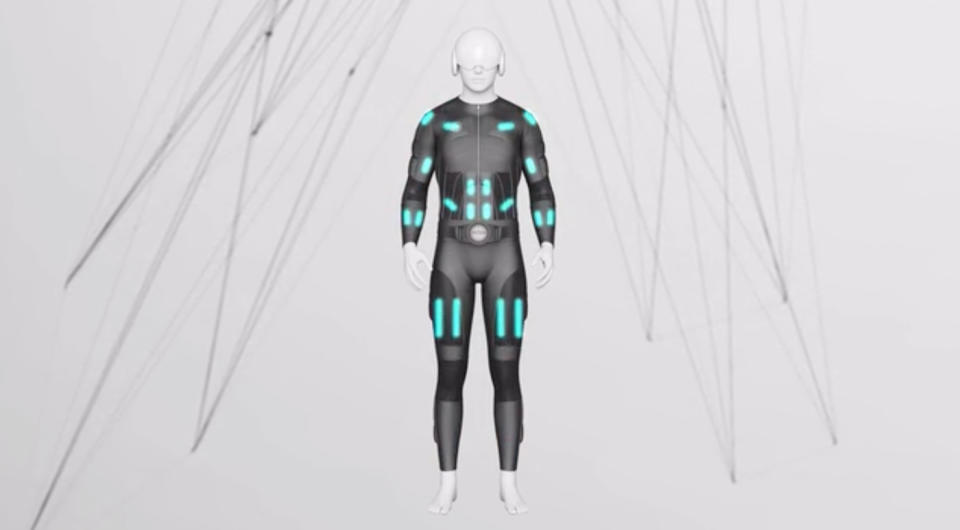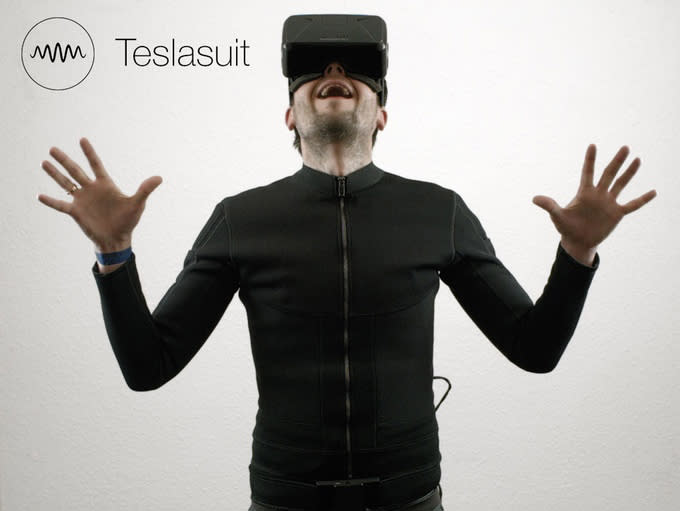Teslasuit does full-body haptic feedback for VR
It uses electrical stimulation to imitate anything from an explosion to in-game weather.

Smartphone-powered headsets like Google Cardboard and Samsung's Gear VR have been worthy stop-gaps for introducing the medium of modern virtual reality. But this year, more resource-intensive VR experiences, games especially, will finally make it into consumers' homes. Pre-orders for the final Oculus Rift opened today, and competitors like Playstation VR and HTC's Vive aren't too far behind. For start-up Tesla Studios, though, pulling on a headset and grabbing a controller just doesn't seem immersive enough. That's why it's developing the Teslasuit, a full-body haptic feedback ensemble for putting you well and truly in the game.
VR promises to be something of a next step in entertainment, so it's not surprising various companies are jumping on the bandwagon early. Many are looking into ways of injecting a bit more "reality" into proceedings, whether it be through controllers or feedback devices. An omnidirectional treadmill or rotating chair might make for a more natural control scheme, for example; similarly, haptic feedback devices could make the virtual world tangible in a way a simple gamepad vibration can't. The Teslasuit is as ambitious as any of these projects, and more than most.
Hoping to raise £250,000 (over $350,000) on Kickstarter to make its haptic suit a reality, Tesla Studios has two models in mind: The Pioneer, with 16 individual points of feedback across the upper and lower body -- or 30, depending on what part of the campaign page you're looking at -- and the Prodigy, which has 52 discrete "channels." The washable, neoprene two-piece is interlaced with conductive thread that tricks the senses using neuromuscular electrical stimulation. That's mild, localized electric shocks in human speak, making the Teslasuit kind of like a full-body, low-power version of those ab-building devices you see in infomercials. To complete the get-up, the comic-esque T-Belt contains the brains, Bluetooth radio and a battery that "could" drive the suit for up to four days with moderate use.
By lightly zapping various points all over your body, the Teslasuit promises to create "a range of tactile sensations." With different strengths and durations of impulse, it's pitched as being able to mimic anything from basic interactions with objects in the virtual world to the impact of bullets and explosions -- even in-game weather can be translated into electrical stimuli, with optional temperature control modules for added effect. The Teslasuit is planned to ship with a piece of haptic editor/player software in which to create pre-programmed stimulation routines, as well as a VR paintball game (a proof-of-concept, if you will). Beyond gaming, there's also a "virtual meetings app" that allows you to touch and be touched by avatars, but let's no go plummeting down that rabbit hole.

Having seen innumerable crowdfunding pitches, we tend to have a gut reaction to campaigns, and our spider-senses are tingling here (not by neuromuscular electrical stimulation, we should add). The product itself, the funding goal and the delivery estimates are relatively ambitious, but it's the chicken and egg problem that's the real red flag. Consumer VR is still in its embryonic infancy, and the likelihood of developers going out of their way to support the Teslasuit accessory in their games and other experiences might be a tall order, especially if there are few out in the wild. In the future, there will almost certainly be opportunities for value-adding VR peripherals that excite developers. Right now, though, the Teslasuit concept may be a little ahead of its time.

